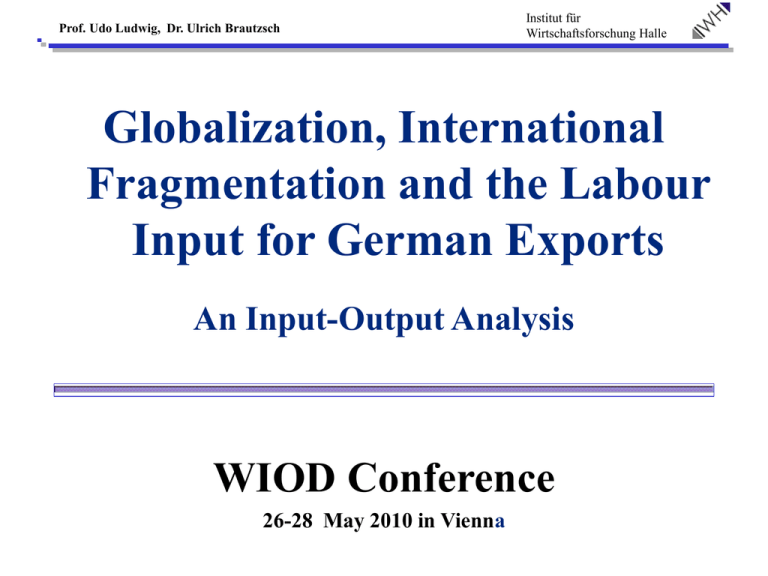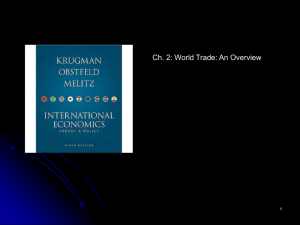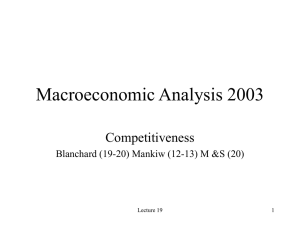Slides Ludwig & Brautsch
advertisement

Prof. Udo Ludwig, Dr. Ulrich Brautzsch Institut für Wirtschaftsforschung Halle Globalization, International Fragmentation and the Labour Input for German Exports An Input-Output Analysis WIOD Conference 26-28 May 2010 in Vienna Prof. Udo Ludwig, Dr. Ulrich Brautzsch Institut für Wirtschaftsforschung Halle Questions to be answered How have German export and its import content developed over the past decades? How does the growth in exports impact employment and income compared to its loss as a result of increased import penetration? Which employee skills levels are impacted more than average by the import penetration of export production? Institut für Wirtschaftsforschung Halle Prof. Udo Ludwig, Dr. Ulrich Brautzsch The Method Standard Open Input-Output-Model where: -1 x= ( I- A) y A x y = Matrix of Technological Coefficients = Gross Output = Final Demand Export-Induced Imports imex = Aim ( I-Ad )-1 ex where: ex im = Import Content of Exported Domestic Goods Aim = Matrix of Coefficients of Imported Intermediaries d = Matrix of Coefficients of Domestic Intermediaries = Exports A ex Institut für Wirtschaftsforschung Halle Prof. Udo Ludwig, Dr. Ulrich Brautzsch German Exports and their Import Content in the period from 1980 until 2006a - at current prices 1980 1985 1991 1996 2000 2005 2006 bn Euro [1] Exports [2] Export goods produced domestically [3] Re-exports 188,7 283,3 374,1 453,3 670,6 900,5 1 031,2 181,1 268,0 347,5 404,4 576,6 760,0 863,9 7,6 15,3 26,6 48,9 94,0 140,5 167,2 [4] Export induced imports 47,0 76,0 99,9 129,3 251,1 358,2 435,0 [5] Intermediate goods 39,4 60,7 73,3 80,4 157,1 217,7 267,8 [6] Re-exports 7,6 15,3 26,6 48,9 94,0 140,5 167,2 in % [7] Import content of exports ([4]/[1]) 24,9 26,8 26,7 28,5 37,4 39,8 42,2 [8] Intermediate goods ([5]/[1]) 20,9 21,4 19,6 17,7 23,4 24,2 26,0 [9] Re-exports ([6]/[1]) 4,0 5,4 7,1 10,8 14,0 15,6 16,2 21,8 22,6 21,1 19,9 27,2 28,6 31,0 Memo item: [10] a Import content of exports produced domestically ([5]/[2]) The figures for the years 1980 and 1985 refer to the Federal Republic of Germany before reunification. Source: Federal Statistical Office of Germany: Input-Output-Tables; authors` calculations. Prof. Udo Ludwig, Dr. Ulrich Brautzsch Institut für Wirtschaftsforschung Halle At first glance the import content of German exports increased in the 1990’s to almost 40%. Behind this growth a strong change in the composition of German exports is hidden in favour of re-exports. The rate of re-exports in the total import content of exports quadrupled from 4% in 1980 to 16% in 2006 whereas the rate of export-induced intermediate imports increased from 20% to 26%. The strongest change was observed in the second half of the 1990’s. At second glance the import penetration of German export goods produced domestically also enhanced but less dramatically. It started from 22% of the exports in the 1980’s and reached almost 30% at the end of the 1990’s. Institut für Wirtschaftsforschung Halle Prof. Udo Ludwig, Dr. Ulrich Brautzsch Composition of German Exports - in billion Euro 1 200 Re-exports 1 000 Domestic Products 800 600 400 200 0 1980 1985 1990 Sources: Federal Statistical Office Germany; IWH calculations. 1991 1996 2000 2006 Institut für Wirtschaftsforschung Halle Prof. Udo Ludwig, Dr. Ulrich Brautzsch Composition of Export-Induced Imports - in billion Euro 500 450 Re-exports 400 Intermediate Goods 350 300 250 200 150 100 50 0 1980 1985 1990 1991 Sources: Federal Statistical Office Germany; IWH calculations. 1996 2000 2006 Institut für Wirtschaftsforschung Halle Prof. Udo Ludwig, Dr. Ulrich Brautzsch Share of Export-Induced Imports in Exports % 45,0 40,0 Re-exports 35,0 Intermediate Goods 30,0 25,0 20,0 15,0 10,0 5,0 0,0 1980 1985 1990 1991 Sources: Federal Statistical Office Germany; IWH calculations. 1995 2000 2005 2006 Institut für Wirtschaftsforschung Halle Prof. Udo Ludwig, Dr. Ulrich Brautzsch Share of Export-Induced Imports in Total Exports and in Domestic Export Goods % 45 40 35 30 25 20 15 10 5 0 1980 1985 1990 1991 1995 2000 2005 Share of exp.-ind. Imports in Total Exports Share of exp.-ind. Imports in Domestic Export Goods Sources: Federal Statistical Office Germany; IWH calculations. 2006 Institut für Wirtschaftsforschung Halle Prof. Udo Ludwig, Dr. Ulrich Brautzsch Stylized Development of the Share of Export-Induced Imports in German Exports % 50 40 30 20 10 1980 1985 1991 1996 2000 Share of exp.-ind. Imports in Exports (total) Share of exp.-ind. Imports in Domestic Export Goods Share of exp.-ind. Imports in Exports (without re-exports) Sources: Federal Statistical Office Germany; IWH calculations. 2005 2006 Prof. Udo Ludwig, Dr. Ulrich Brautzsch Institut für Wirtschaftsforschung Halle Effects of exports on production of goods and use of income Production phase: Effects of exports on value added and employment vaex = xex . * s lex = xex .* b where: vaex s lex b = = = = Vector of Gross value added induced by the export of domestic products Vector of gross value added shares in gross production Vector of export-induced persons in employment Vektor of labor input coefficients per 1 million Euro of gross production Prof. Udo Ludwig, Dr. Ulrich Brautzsch Income use phase: Effects of income induced by exports inex = W * lex ypc = ( 1-k ) * inex xin = ( I-Ad )-1 * ypc where: inex W pc y x in = = = = Income induced by exports Vector of avarage wages of labour force Income-induced additional private consumption Income-induced additional gross production Institut für Wirtschaftsforschung Halle Institut für Wirtschaftsforschung Halle Prof. Udo Ludwig, Dr. Ulrich Brautzsch Net Contribution of Domestic Export Goods to Value Added - in billion Euro 700 600 500 400 300 200 100 0 1980 1985 1991 Sources: Federal Statistical Office Germany; IWH calculations. 1996 2000 2006 Institut für Wirtschaftsforschung Halle Prof. Udo Ludwig, Dr. Ulrich Brautzsch Net Employment Effects of Domestic Export Goods - in thousand persons 10 500 9 000 7 500 6 000 4 500 3 000 1 500 0 1980 1985 1991 Sources: Federal Statistical Office Germany; IWH calculations. 1996 2000 2006 Institut für Wirtschaftsforschung Halle Prof. Udo Ludwig, Dr. Ulrich Brautzsch Balance of Effects on Gross value added and Employment induced by Exports and imported intermediate Goods by main economic sectors in Germany - in % Gross value added Persons in employment Sector 1980 1991 2006 1980 1991 2006 4,2 2,0 -1,7 5,7 5,9 1,8 Secondary 56,3 52,8 44,3 58,0 52,5 38,2 Tertiary 39,5 45,2 57,4 36,3 41,6 60,0 100,0 100,0 100,0 100,0 100,0 100,0 Primary Total Sources: Federal Statistical Office Germany; IWH calculations. Prof. Udo Ludwig, Dr. Ulrich Brautzsch Institut für Wirtschaftsforschung Halle Extension of German IOTs by Skills Method: split of employment input by skills levels Source: households surveys (microcensus): 5 skills levels, 71 industries, 300 occupations, 3 groups of working time, gender Sample: 1 % per year Institut für Wirtschaftsforschung Halle Prof. Udo Ludwig, Dr. Ulrich Brautzsch Skill Levels Low Preparatory education, career preparation year Medium Vocational training, vocational school Master craftsman, technician High Technical college, university of applied sciences University degree, PhD Institut für Wirtschaftsforschung Halle Prof. Udo Ludwig, Dr. Ulrich Brautzsch Balance of Employment Effects of export induced Production and imported intermediate Goods by main economic sectors and skill levels in Germany: Changes between 1996 and 2006 - 1 000 persons - Primary Secondary Tertiary Total Low - 40 - 67 419 312 Medium - 39 378 1 387 1 726 High - 14 83 585 654 Total - 93 394 2 391 2 692 Sources: Federal Statistical Office Germany; IWH calculations. Institut für Wirtschaftsforschung Halle Prof. Udo Ludwig, Dr. Ulrich Brautzsch Employment Effects of export induced Production and imported intermediate Goods per 1 million Euro of Exports by main economic sectors and skill levels: Changes in Germany between 1996 and 2006 - in persons Primary Low production imports total Medium production imports total High production imports total Total production imports total Secondary Tertiary Total -0,18 -0,02 -0,16 -1,29 -0,09 -1,21 -0,66 0,01 -0,67 -2,13 -0,10 -2,04 -0,28 0,00 -0,27 -2,61 -0,10 -2,51 -1,26 0,05 -1,31 -4,15 -0,05 -4,09 -0,03 0,01 -0,04 -0,41 -0,01 -0,40 -0,01 0,04 -0,04 -0,44 0,04 -0,48 -0,49 -0,01 -0,47 -4,31 -0,19 -4,12 -1,92 0,10 -2,03 -6,72 -0,11 -6,62 Sources: Federal Statistical Office Germany; IWH calculations. Institut für Wirtschaftsforschung Halle Prof. Udo Ludwig, Dr. Ulrich Brautzsch Conclusions Positive balance between gains due to growing exports and the losses caused by increasing import content of the exports. Production of export goods outdoes the labour intensity of export induced imports. There is a positive balance in skill content between exports produced domestically and export induced imports.







